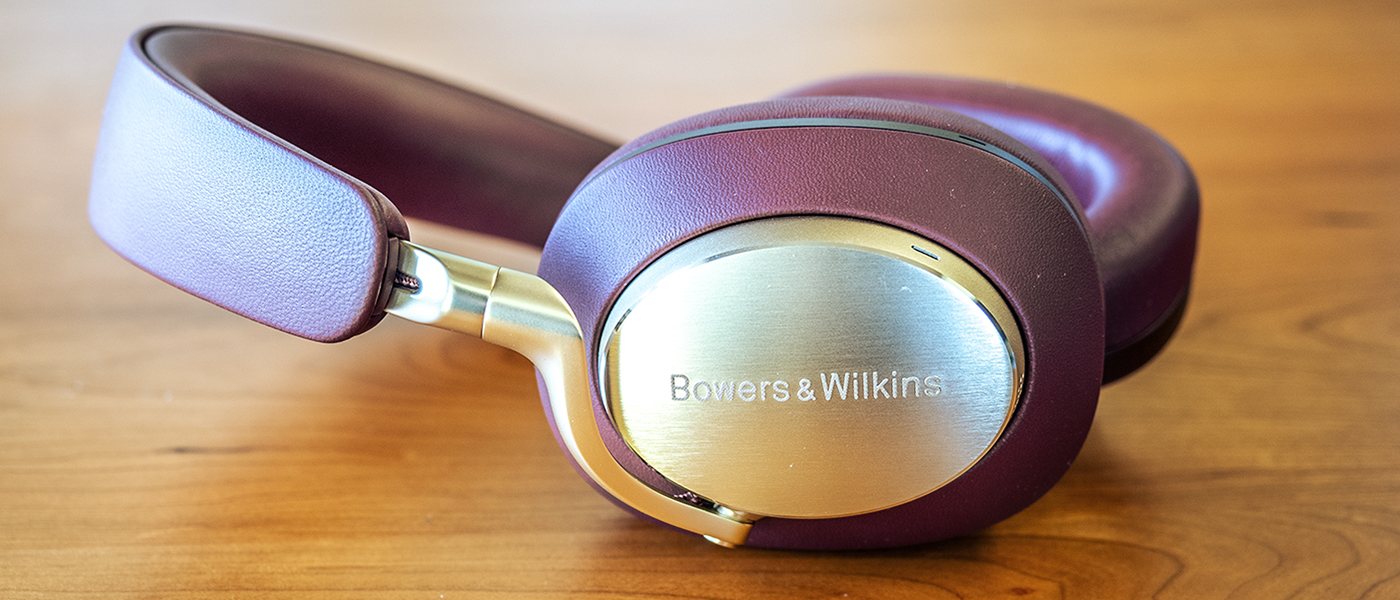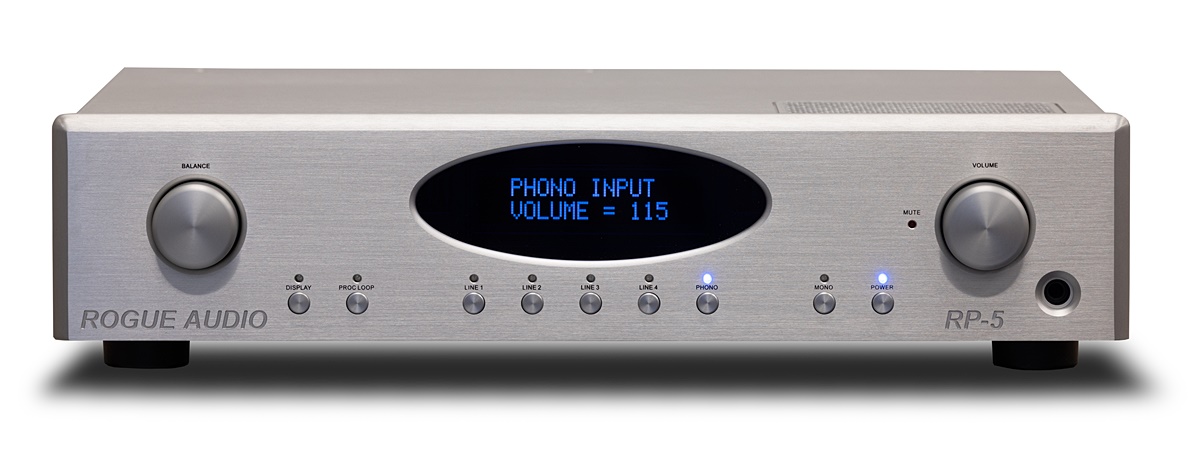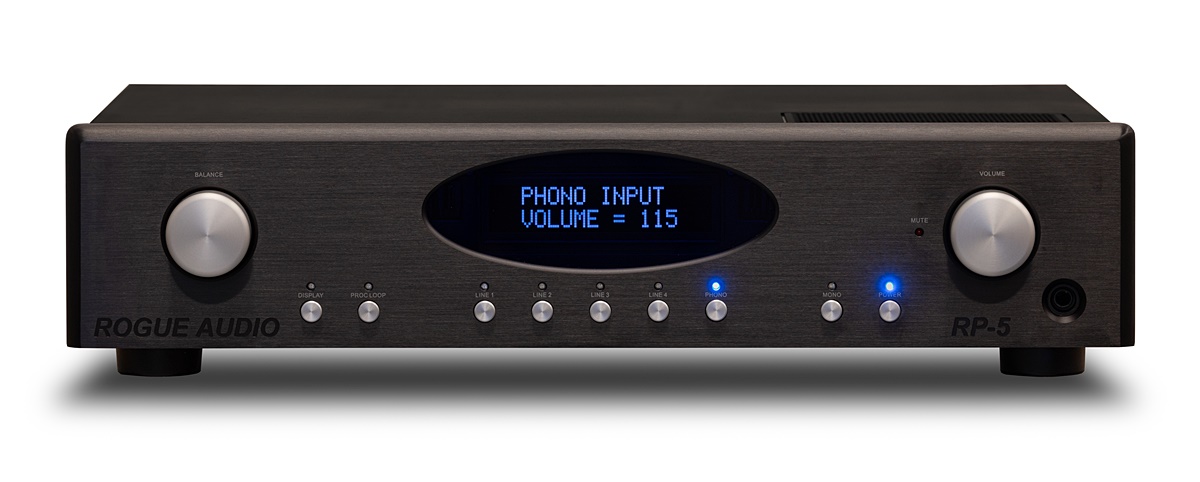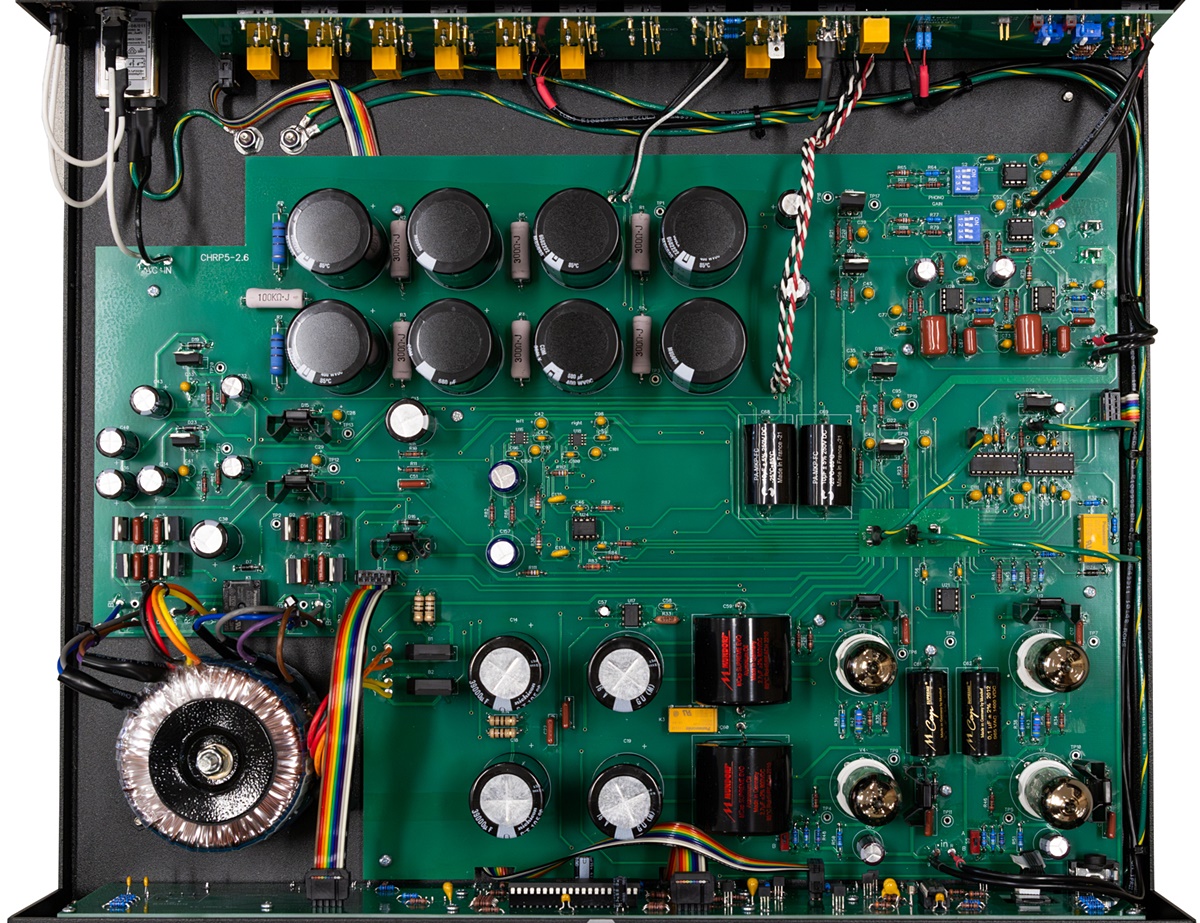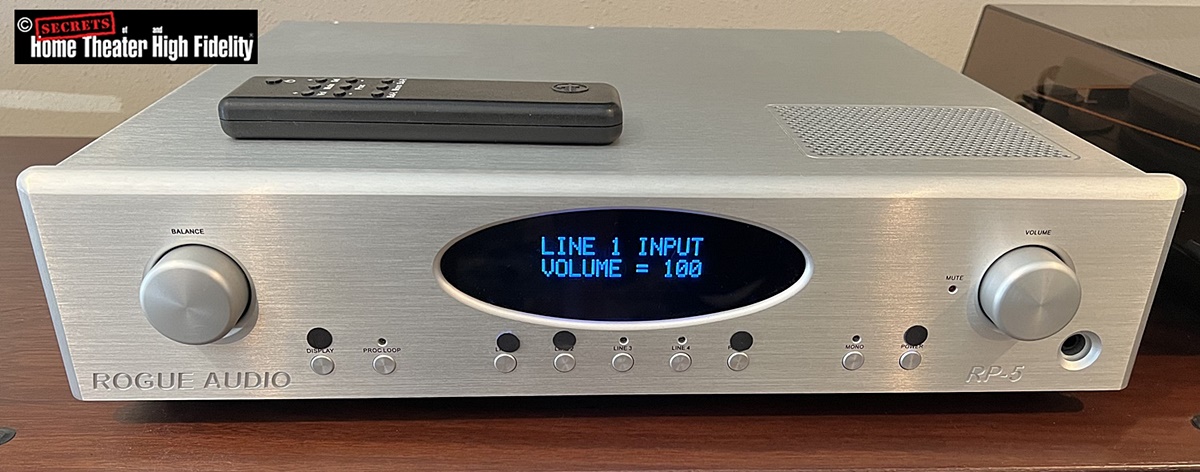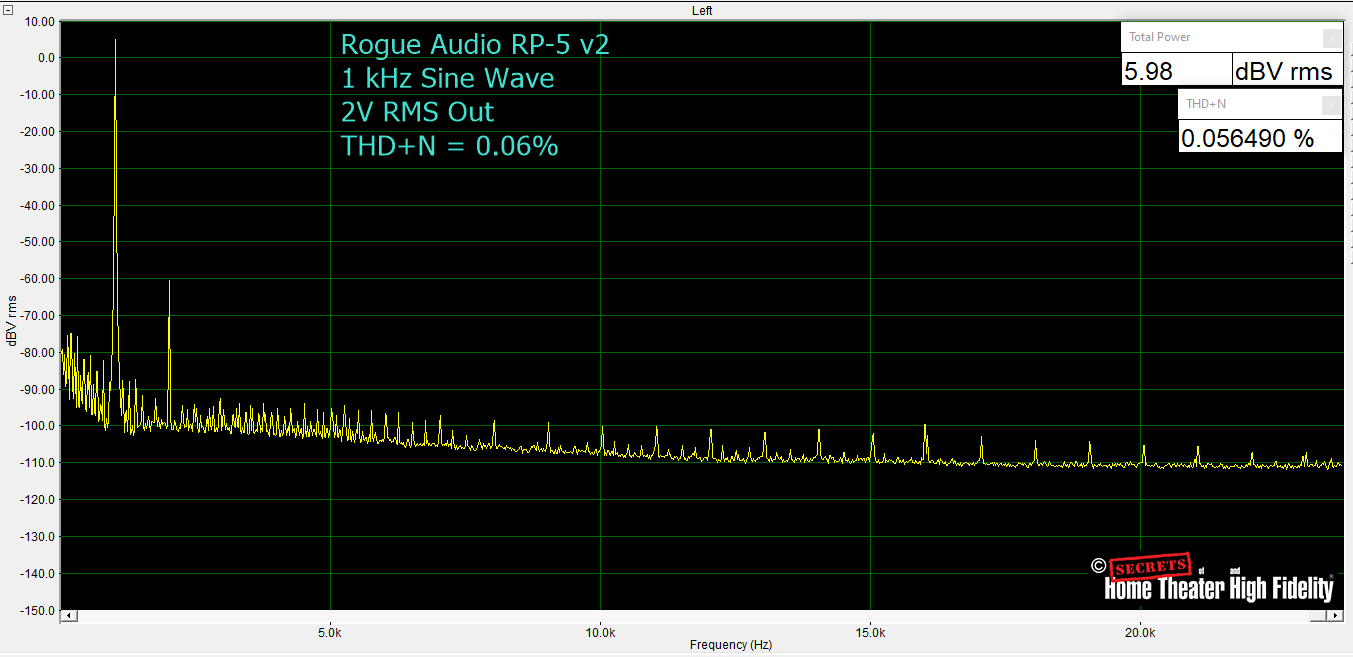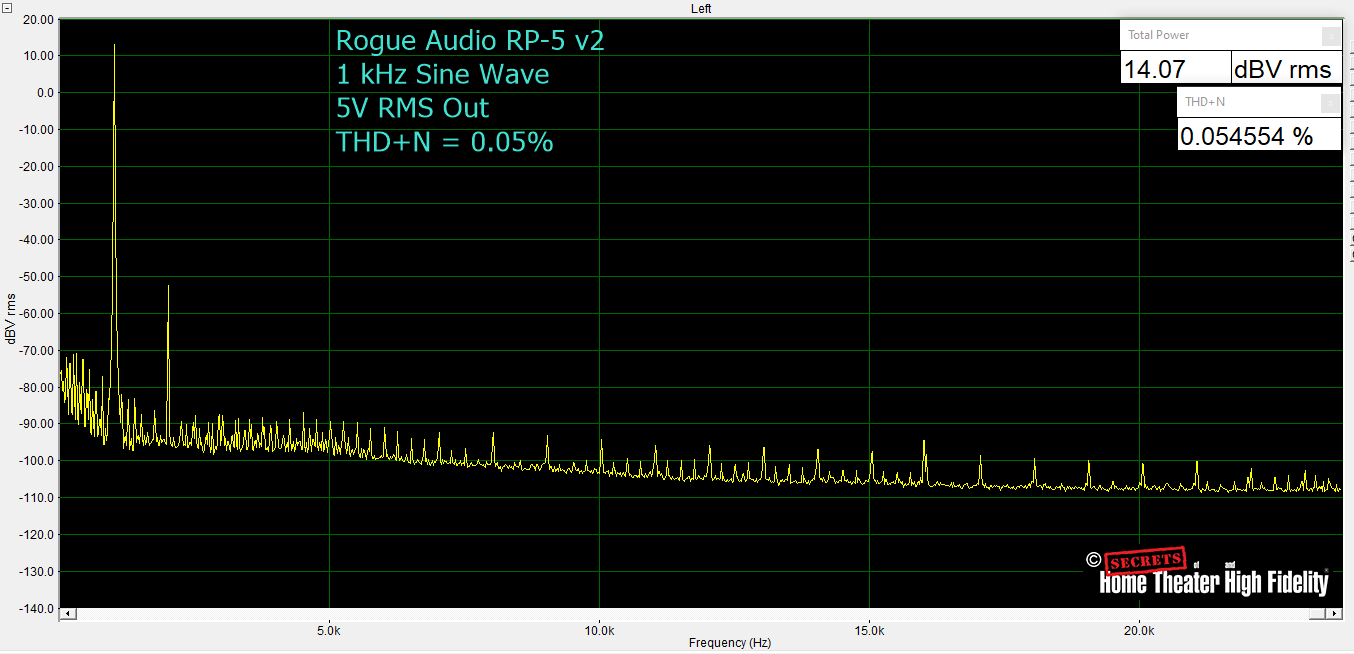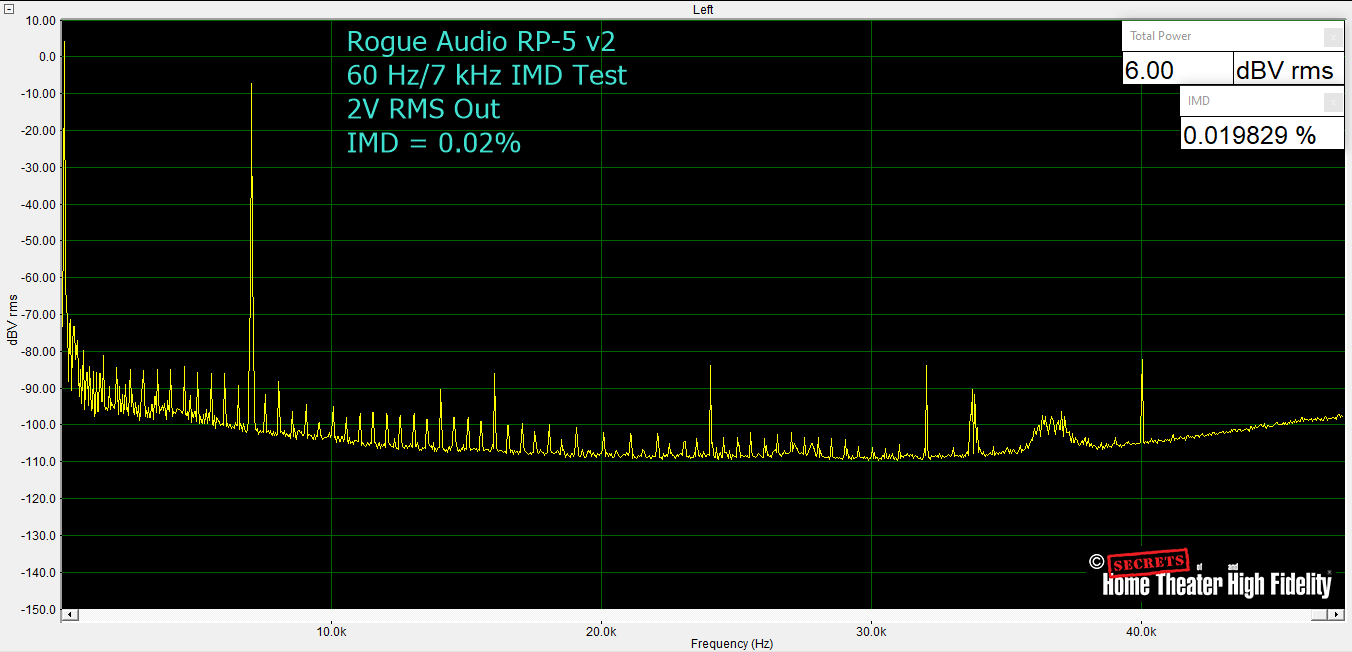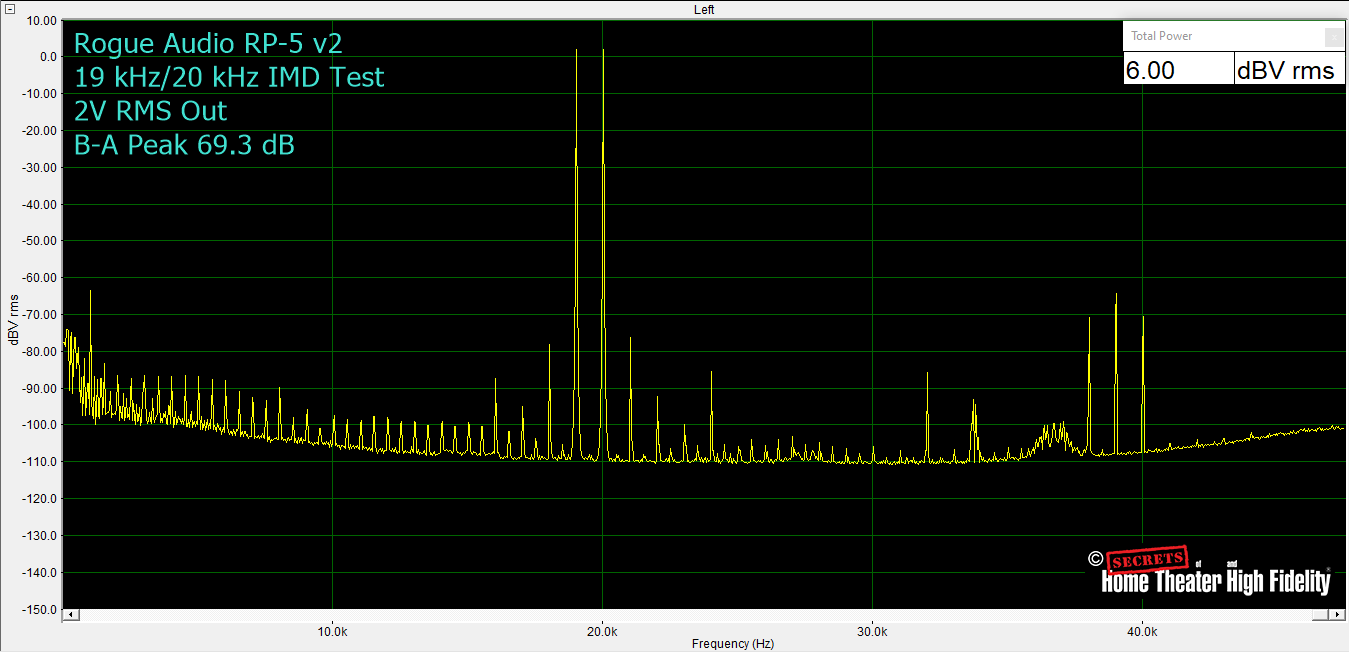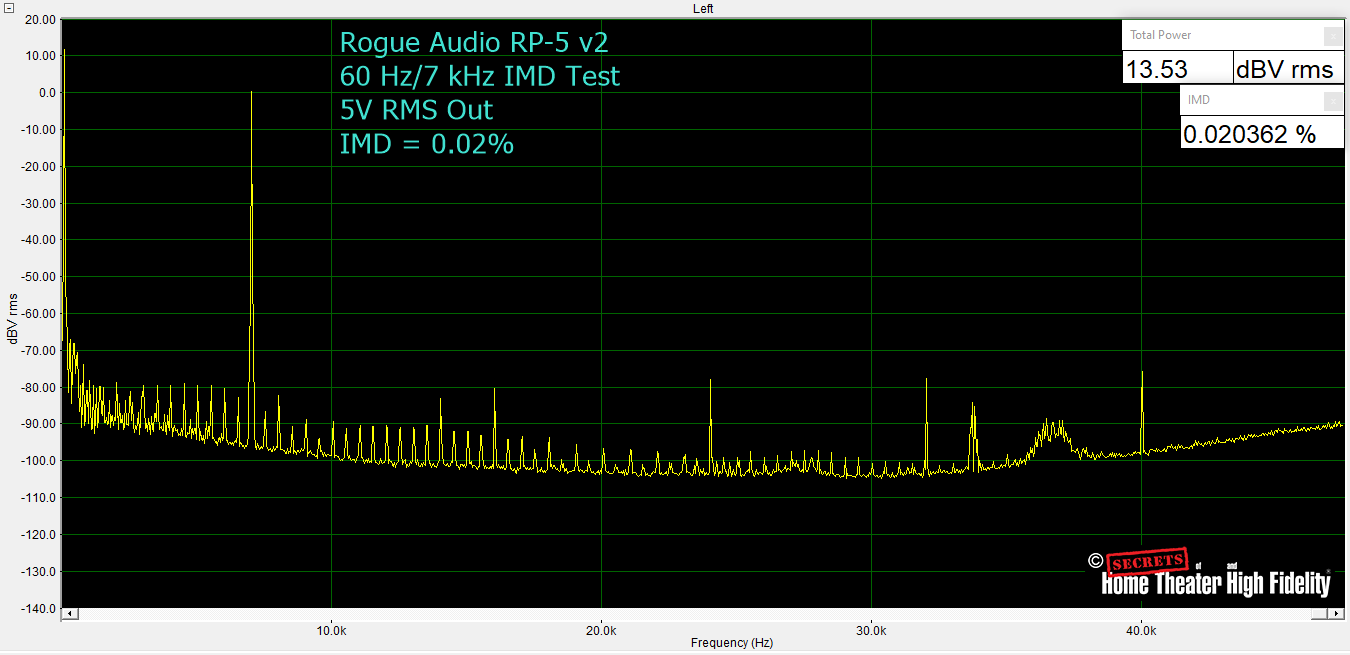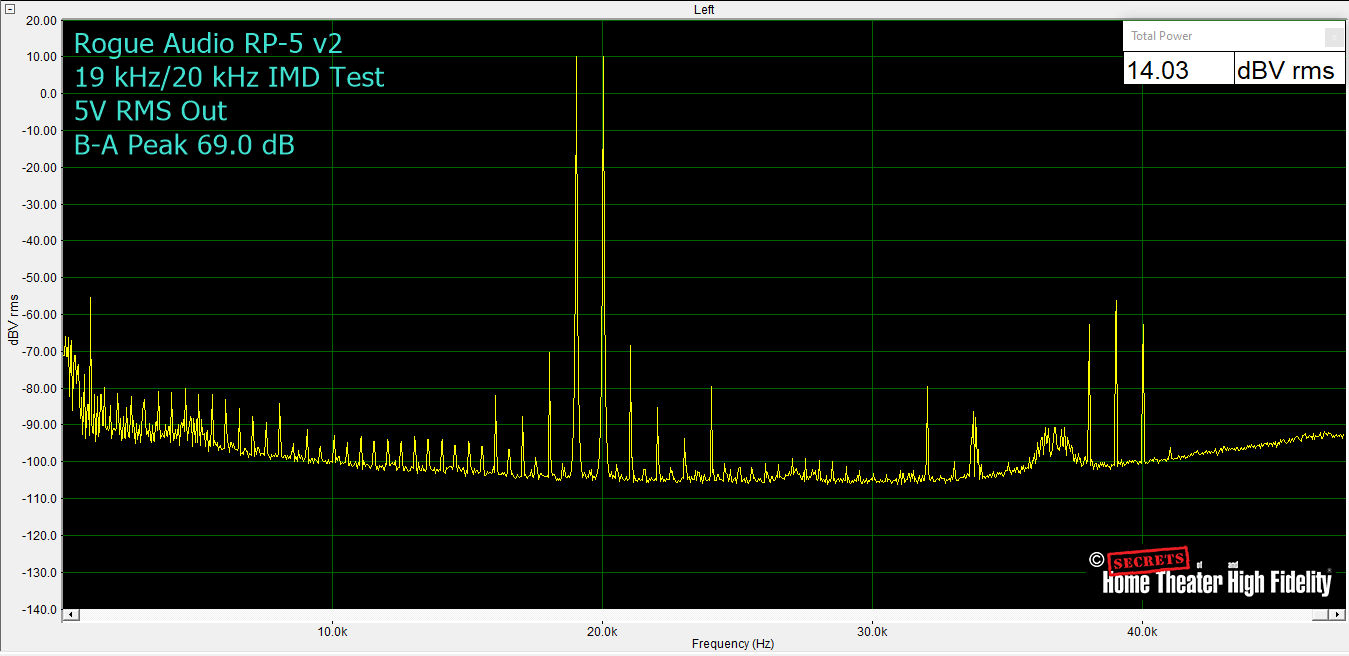The new Rogue Audio RP-5 v2 preamplifier requires a long-ish break-in period to start sounding its best. Your patience will be rewarded with an engaging and fluid musical presentation. The RP-5 v2 has some operational quirks that add to its charm. It was a fun engagement while it lasted, and I will genuinely miss this fun-loving preamplifier.
Rogue Audio RP-5 v2 Preamplifier Highlights
- Excellent build quality on the actual component.
- Very flexible set up and use options.
- Slightly quirky and unique operation and user interface.
- Handy, lightweight remote for basic functions.
- Well-executed phono stage.
- Competent headphone amplifier included.
- Pinpoint sound staging.
- Fluid musical reproduction.
- Break-in required for the best performance.
I have read positive reviews on Rogue Audio gear, and I have heard their components at various trade shows but I never had hands-on experience with any of the Rogue components until this review. When I made contact about a possible review unit, Rogue said I should wait a few months because they were involved in a complete upgrade of the RP-5 which is now dubbed the RP-5 v2! There were some additional delays in the final stages, but I know Rogue wanted to make sure everything was up to their standards before shipping the new units. So, I waited patiently for a little longer.
The component in question is the middle-of-the-line Rogue preamplifier. It is dubbed the RP-5 v2 and has undergone some extensive updates over its original incarnation. For the record, it is a tube-based, unbalanced stereo preamp that has a ton of hook-up flexibility including an MM/MC phono input, a built-in headphone amp, multiple line-level inputs, an HT pass-through, and dual variable line-outputs. It also has a balance control that is accessible from the remote. It sports the iconic Rogue oval readout which has been upgraded to OLED with the new version.
It’s a well-made component so please read on and see if it lives up to my expectations!
Design:
Four Tube Mu-follower
Tube Complement: Four 12AU7/ECC802
Frequency Response (MFR):
5 Hz – 100 kHz +/- 1dB
THD:
<0.1%
Gain:
11dB
Rated Output:
1V RMS
Output Impedance:
<100 Ω
Phono Stage Gain:
43dB, 48dB, 57dB, 65dB
Dimensions:
18.5” W x 17” D x 4.5” H
Weight:
30 Pounds
MSRP:
$3,995 USD
Website:
Company:
SECRETS Tags:
Rogue, Rogue Audio, RP-5, v2, Preamplifier, Tube
Rogue Audio just released a fully updated RP-5 preamplifier which has been dubbed the Rogue Audio RP-5 v2. Unlike some companies’ idea of an upgrade, which can be minimal at best, Rogue Audio has implemented a full 360-degree component upgrade of nearly every facet of the unit’s design and construction.
The original RP-5 was the first Rogue preamp that was based on their “RP-X” platform. Rogue has released numerous other products in the intervening years. Each of these products had newer circuit designs and incrementally improved performance. The lessons learned from a number of these improved products have been incorporated into the RP-5 v2, making this upgraded preamplifier the winner of a real trickle-down design upgrade.
Some of the products that established the improved circuitry are the RP-7, RP-9, RH-5, and Triton II. According to Rogue Audio, “The new RP-5 v2 improves both sound quality and overall performance well beyond that of the original.”
Here is a short sampling of some of the significant upgrades –
- The volume control now has the same refinement as the RP-7 and RP-9 with 200 steps (0.5dB each) via an optical encoder.
- There is a buffer stage on the output of the tube stage which reduces the output impedance.
- The RP5 v2 incorporates larger DC blocking caps which also keep the output impedance very low while improving bass response.
- The phono stage has been re-designed based on the Triton II dedicated phono preamp and provides improved performance along with higher gain and a lower noise floor.
- The headphone circuit now has a MOSFET buffered output which provides higher performance and more power than the original RP5.
- The new OLED readout can be turned off by a front panel push button.
The Rogue RP-5 v2 has unbalanced inputs and outputs only. Some audiophiles may scoff at this decision, but I don’t see it as an issue for normal, rational use in a typical system. If you feel you need balanced connections, then you can check out their upgrade preamps, the RP-7 or the RP-9. In my typical setup, my interconnects are around 6’ or less, so I don’t have any practical need for balanced connections.
One thing that really stands out to me regarding the RP-5 v2 is its incredible versatility. As a high-end reviewer, I can always use a component with all these useful features. Let me discuss a few of them below:
The RP-5 v2 has a balance control that is accessible from the front panel and the remote. I rarely sit right in the exact sweet spot for a number of reasons, so I personally find having a balance control that is accessible via remote to be an essential feature.
There is a “mono” mode which I use with some older stereo recordings that may be wacko when it comes to the L/R mix. This feature is also available via the remote, which is quite nice as well.
The large display is welcome as it is readily legible from the listening chair. It can be defeated but the LED that indicates the display is off is, in fact, subjectively brighter than the display itself. So, in my view, this is a swing and a miss.
The RP-5 v2 has an HT bypass which is handy for a reviewer to be able to incorporate the preamp into a real-world environment. There is also a processor loop that one may use to incorporate a product like a BACCH-SP-Dio, for example. I guess you could put an equalizer in there as well, but I won’t be doing that!
It has a separate, fixed output that can be useful for various hook-up needs depending on what I have in for review, like a small passive preamp with limited inputs or if I want to use the RP-5 v2 phono stage with an integrated amplifier.
Not only is the phono stage eminently competent, but it is also extremely flexible with settings to match almost every MM or MC cartridge on the market. Did I mention it sounds really sweet?
I also enjoy having a lot of regular inputs though I rarely use more than 2 at a time (1 turntable and 1 DAC which has multiple inputs). Probably the most useful feature for me is the second set of variable outputs. Even though my main speakers have excellent bass extension, I still like to add a subwoofer crossing over at about 50 Hz to kick up the bass a little. But, more importantly, the subwoofer somehow adds a layer of envelopment that is quite addictive!
I also want to make note of the impressive build quality of the Rogue RP-5 v2. I didn’t take off the top cover myself, but Rogue has a high-res image of the unit’s internals you can see here. All the visible parts and bits are of high quality. The tubes (4~12AU7) are improved long plate designs. I was equally impressed with the small, vented portion of the top of the case which is in fact machined as opposed to being stamped like so many other brands would do.
It has a handy (albeit very lightweight) remote control with most of the essential functions at your fingertips. I did not see it on the Rogue Audio website, but I understand they offer a black aluminum remote for an additional charge of $125.
Finally, the RP-5 v2 comes complete with a powerful, dedicated headphone amplifier. This headphone amplifier benefits from the Rogue circuitry which is capable of pretty significant output voltages and this unit drove my HiFiMan HE1000 v2’s without any signs of strain or distortion.
Secrets Sponsor
The associated equipment I used for this review are as follows – PS Audio AirLens as my Roon endpoint, an Oppo BDP-105D for disk playback, a Topping D90 DAC, a Pass Labs XP-17 Phono Stage (for comparison to the built-in Rogue phono stage), a MoFi Ultradeck with an Ultratracker cartridge for vinyl playback, a pair of D-Sonic M3a-1500M monoblock amplifiers, a pair of VIVID Kaya 90 floor-standing speakers, and an SVS SB 16 Ultra subwoofer for bass augmentation. As mentioned above, I also employed my beloved HiFiMan HE1000 V2’s in evaluating the headphone amplifier.
All my interconnects are either Clarus Crimson or a mix of various AudioQuest flavors with Clarus Crimson speaker cables. I am using a PS Audio HDMI cable for the I2S input to the Topping DAC. I also have a pair of low- capacitance interconnects for the subwoofer. These are actually Monster Cable brand!
I want to make note here that I have previously opined that the D-Sonic amps had limited bass output and I regret stating it this way as that is wholly unfair to D-Sonic. I think what’s going on is that the output impedance of the D-Sonic amps is so low that they tend to have a very tight grip on my woofers. That tightness in the bass response can be wrongfully interpreted as a reduced bass extension. But after many more hours enjoying these amplifiers, I want the record to show that these amplifiers have excellent bass response, and my system really sings with loads of distortion-free and very tight bass!
I set up all this and wired in my subwoofer with the extra set of variable outputs. Once I had everything set up, I tuned the subwoofer by ear. The SVS does have a 2-band parametric EQ that I have set up using a calibrated microphone and FEA software. The sub’s EQ was engaged, and I tuned the crossover, the phase, and the level by ear to where I was getting a really excellent blend.
One quirk with the Rogue is that the display on/off switch only turns off the OLED readout which isn’t really that bright. The overly bright parts are the unnecessarily bright (and blue) LED’s which signify which of the front-panel buttons are engaged. So, if you decide to turn off the display (presumably for some late-night listening) then a substantially brighter LED lights up as a reminder that you have the less annoying display turned off. It’s almost like a sick joke. I solved this by punching out some black dots from a piece of card stock and then, using removable adhesive “dots”, I placed the black paper over the offending LEDs. See the above image which I call the RP-5 v2 in “Full Battle Rattle Mode”.
There is one other operational quirk that was only a slight nuisance. There isn’t a “mute” button on the front panel and the only way to unmute the unit is to depress the mute button on the remote a second time. You can’t mute or unmute from the front panel. I would at least like to be able to unmute it by turning up the volume control, but this preamp did not work that way.
Anyway, once everything was set up and dialed in, I settled down for long-term listening tests followed by some basic bench tests.
Secrets Sponsor
I have had a lot of experience with high fidelity over the many years of my life. And that experience has increased and accelerated over the 15 years I have spent as an active high-end reviewer. In this role, I replace equipment in my system way more frequently than any normal person. (Well, I guess we all know that one guy!) Anyway, I rotate new pieces through here quite regularly. I always used to believe that component break-in was some sort of a myth (except with speakers of course). My belief system has changed, and I now feel that break-in is a real thing and not just a period of acclimation by the listener.
This new belief system of mine was supported through my experience with the Rogue RP-5 v2. When it was new out of the box and freshly hooked up, I really didn’t like it much at all. It was soft, aloof, and lacking dynamic integrity. It was very uninspiring if you know what I mean. It was a chore to fire it up and play some music. I even made early comparisons to an inexpensive passive preamp I own which simply blew away the Rogue. But I persevered and following about 50 to 60 hours of use, the damn thing started to sing like crazy! I’m not sure if the tubes or the fancy capacitors needed time to break in, but I can say with confidence that the performance morphed from lame-o to hero over the warm-up period and the Rogue wound up being among my favorite preamps that I have had in my system!
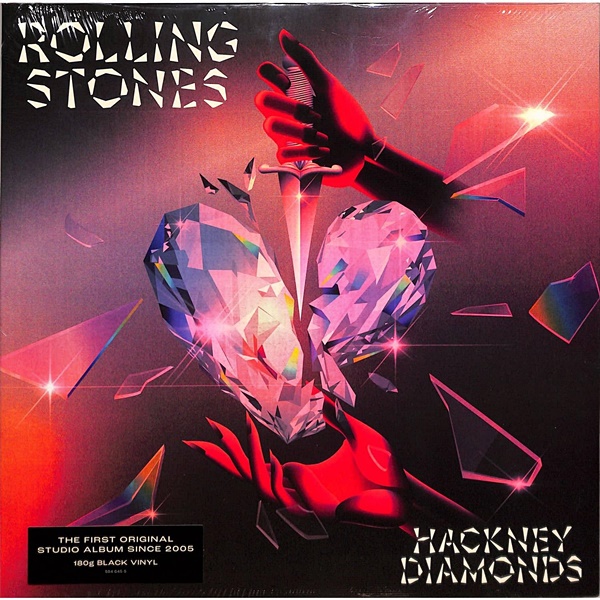
Rolling Stones “Hackney Diamonds”
The first music up for evaluation was the Rolling Stone’s new release, Hackney Diamonds. This is an album that was highly anticipated and has largely met with positive reviews upon its release. Audio-wise, it definitely isn’t a bastion of high-end audio reproduction, but I have enjoyed it tremendously which is a bit of a surprise because I would never claim to be a serious Stones fan.
When it came to evaluating the Rogue RP-5 v2, the vocal clarity on “Get Close” really shone. I also loved how the Rogue handled the substantial bass throughout. This is obviously a modern album, and the bass is much more prominent than what would be heard on a 1970s effort, for example. Maybe that’s part of what I like about this record and the Rogue gladly obliged. All in all, I enjoyed this record, and the Rogue was a major participant in my enjoyment of it.

Bill Evans Trio “Sunday at the Village Vanguard”
I recently picked up the Craft Recordings LP of Bill Evans Trio Sunday at the Village Vanguard. This record has been getting a lot of love online recently including from our very own Jason Crawford. Though I’m not as “gaga” as some others, the album does have its charms and the technical accomplishment is undeniable.
I listen to the Bill Evans album via the built-in phono preamp. Though it is not as transparent as my Pass Labs XP-17, the Rogue nevertheless provided a very satisfying performance. One thought that came out in my listening notes was a sense of a “fluid musicality”. This was a persistent listening impression I had with The Rogue RP-5 v2. However, I felt that the system was a little reticent in terms of micro dynamics, particularly in comparison to a passive preamp I use for some basic comparisons. But this record was an outlier insofar as the drums sounded surprisingly live over the Rogue.
I also heard and enjoyed all the ambiance of the venue. Take “Solar” as one example. Not only can you hear the audience noises, but I also hear the lifelike sound of Scott LaFaro’s fingers on the strings across a backdrop of sweet drumming and the “inconsiderate” audience making audience noise (and talking!) All this came to the fore on the bass solo.
Did I mention Evans’ piano yet? Well, it’s a versatile instrument: Bill Evans was a jazz virtuoso, and the RP-5 allowed all this to be front and center. So, the piano was melodic and percussive in equal parts. The Rogue provided a very natural representation of a real-world instrument. “Alice in Wonderland” was another standout where the piano in particular had a starring role throughout the forte passages during which the bass really anchored the ensemble. The Rogue RP-5 v2 made it all sound so musically satisfying.

Dolly Parton “Rockstar”
Next up was Dolly Parton’s latest effort, Rockstar. I streamed this album in high resolution from Qobuz with the PS Audio AirLens serving as my Roon endpoint. This album was promoted so hard, I should have anticipated that it wouldn’t be that great. I did hear a short clip of “Let It Be” with Paul McCartney and Ringo Star that stimulated my interest. In the end, though, this album is bloated and over-produced, and it is wearying to hear Parton’s singing voice for almost 2 and 1/2 hours. On the plus side, the Rogue RP-5 was sufficiently revealing, and I was able to hear some iffy overdubs. But don’t think I didn’t enjoy much of this album. It really is like a soundtrack to my life, and it is fun, especially hearing from some of the older stars who show up on there. I also enjoyed the full range response; this album does rock indeed.
The bass lines in “Every Breath You Take” were really well done on this record. “Baby, I Love Your Way” has a satisfying arrangement and I love hearing Frampton on there, but the song is undone by over-compression like so much of this album. Again, the Rogue passed it all without excessive editorialization.
What about “Let It Be” now that the full album has been released? Well, it’s still my favorite song on the album. Over the Rogue, the vocals came through loud and clear. The drums were also a standout here with the Rogue passing the overly splashy cymbals without any obvious interference.
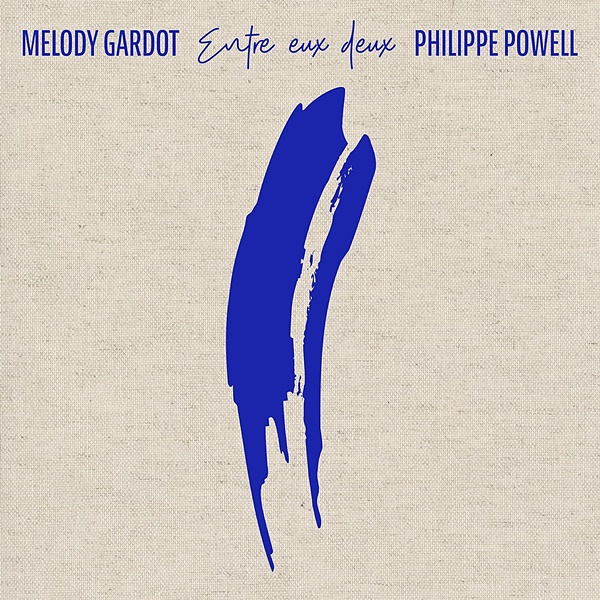
Melody Gardot “Entre eux deux (Between Us Two)”
I want to close out my subjective impressions with the LP of Melody Gardot on Entre eux deux (Between Us Two). This is a set of 10 torch songs with Philippe Powell on piano + backup vocals and Gardot handling the lead singing parts. The pressing I purchased is relatively thin vinyl, but the sound quality is absolutely beautiful despite a little more than typical surface noise. In all honesty, I wondered “How can a piano and singer sound so lavish?” Selfishly, as an American who is linguistically challenged, I really wish more of the songs were in English.
Nevertheless, Gardot’s singing is a revelation. She is one of my favorite singers of our time and this minimal arrangement really spotlights her art as a world-class performer. She has an inflection technique in her singing that is immediately identifiable and lends each performance an emotional edge that tends to draw me near. The RP-5 passed her voice in its totality.
I listened to side 2 on my HiFiMan HE1000 V2 headphones so I could bask in all the gorgeous piano. They say the piano is difficult to reproduce via vinyl, but I didn’t hear any wavering or other distortions in the reproduction of the piano particularly on “Recitativo”. The headphone amp in the RP-5 v2 can’t compete with my stand-alone Burson unit, but, similar to the Rogue’s phono capabilities, it is far from an afterthought, and it is obvious real effort went into its design and implementation so much so this preamp could easily serve all these functions in a legitimate high-end system, and you would not need to make any excuses for it.
All below tests were run with one channel driven. The signal was fed through the left channel input to the left channel speaker output.
The first test I ran on the RP-5 v2 was a 1 kHz sine wave at 2V RMS into my USB sound card which has a 60 kΩ input impedance. THD+N measured 0.06%. The 2 kHz harmonic is the only significant harmonic in the plot, and this would be heard as a “natural” sound consistent with tube amplification.
I also tested the THD+N at 5 Volts and the results were a lower calculated THD + N of 0.05% but in this case, the higher-order harmonics are visible above the noise floor/hash in the plot. But this result would also present a “mellifluous” reproduction of the music.
This next test is the Intermodulation Distortion Test with signals at 60 Hz and 7 kHz at a 4:1 ratio. The test was run at 2V out first. The RP-5 v2’s measured IMD at 6 dBV (2 Volts) came in at 0.02%.
I ran the same IMD test at 4.7V (13.5 dBV). I wanted 5V but the most I could get with the RP-5’s gain set to “200” was 4.7 V. In any event, the IMD measured 0.02% in this test.
This is the other IMD Test we run with signals at 19 kHz and 20 kHz at equal gain. The B-A peak is the difference between the test signal and the level of the 1 kHz tone generated in sympathy to the two test tones. I measured this on-screen and got a B-A peak response of -69.3 dB at 2 Volts output.
Then at 5V, the B-A peak was similar and checked in at -69.0 dB.
I also tested the frequency response of the Rogue RP-5 v2 at 2 Volts output. The preamplifier was essentially flat from DC to 30,000 Hz and dropped by approximately 0.5 dB at 40 kHz. My sound card was set to a 96 kHz sampling rate, so the filters did not allow any accurate assessment beyond this point.
All in all, these are decent results and largely within the manufacturer’s stated claims.
Rogue Audio’s RP-5 v2 is a very flexible and musical preamplifier that is built to last as the heart of a great hi-fi system.
- Excellent build quality on the component
- Useful remote control
- Fluid musicality
- Sweet treble
- Enjoyable bass response
- Highly versatile
- Better quality remote control
- Dimmer or dimmable front LEDs
- Other operational refinements
The Rogue Audio RP-5 v2 was a whole lot of fun for me to review. It kind of marches to the beat of a different drummer and its quirks were part of the charm of using it.
It is very well built to begin with. Even the small metal plate with holes to vent the tubes is machined and not stamped like some other manufacturers would do. It is also packed with oodles of high-quality parts inside.
It is a tube-based product and the tubes do not limit the high-frequency performance but tend to round off the sharp edges like a 200-grit sandpaper. This effect can be interpreted as a loss of microdynamics, but just keep in mind that isn’t what is happening. The tube-i-ness simply lends an organic quality to the sound and the overall impression was of a fluid musicality. Music magically flowed unencumbered by the Rogue.
The RP-5 v2 required a fairly long break-in period before it sounded its best. So please be patient with it. I do wish the upgraded remote was the included remote but the one that comes with it worked fine and is probably pretty reliable. I wanted to hang on to the review unit to toss around the idea of purchasing it, but Rogue has asked me to return it so they can upgrade the firmware as this was a very early production unit. This should resolve an issue where the display would freeze and the only way to fix it was through a power reset.
This preamplifier may not be for everyone, but its build quality and musical prowess make it a must- audition for anybody in the market for a new preamplifier. I may very well request one for purchase in the coming weeks. Either way, I will always remember this as a fun and fluidly musical component that is highly flexible with its myriad hook-up options, phono stage, and headphone amp.


